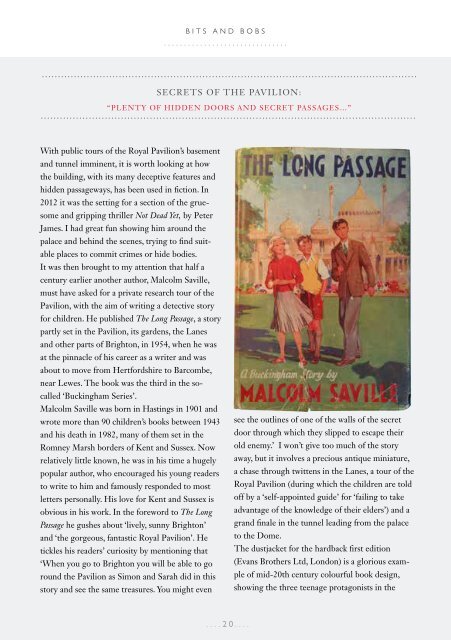Viva Brighton Issue #36 February 2016
You also want an ePaper? Increase the reach of your titles
YUMPU automatically turns print PDFs into web optimized ePapers that Google loves.
its and bobs<br />
...............................<br />
Secrets of the pavilion:<br />
“Plenty of hidden doors and secret passages…”<br />
With public tours of the Royal Pavilion’s basement<br />
and tunnel imminent, it is worth looking at how<br />
the building, with its many deceptive features and<br />
hidden passageways, has been used in fiction. In<br />
2012 it was the setting for a section of the gruesome<br />
and gripping thriller Not Dead Yet, by Peter<br />
James. I had great fun showing him around the<br />
palace and behind the scenes, trying to find suitable<br />
places to commit crimes or hide bodies.<br />
It was then brought to my attention that half a<br />
century earlier another author, Malcolm Saville,<br />
must have asked for a private research tour of the<br />
Pavilion, with the aim of writing a detective story<br />
for children. He published The Long Passage, a story<br />
partly set in the Pavilion, its gardens, the Lanes<br />
and other parts of <strong>Brighton</strong>, in 1954, when he was<br />
at the pinnacle of his career as a writer and was<br />
about to move from Hertfordshire to Barcombe,<br />
near Lewes. The book was the third in the socalled<br />
‘Buckingham Series’.<br />
Malcolm Saville was born in Hastings in 1901 and<br />
wrote more than 90 children’s books between 1943<br />
and his death in 1982, many of them set in the<br />
Romney Marsh borders of Kent and Sussex. Now<br />
relatively little known, he was in his time a hugely<br />
popular author, who encouraged his young readers<br />
to write to him and famously responded to most<br />
letters personally. His love for Kent and Sussex is<br />
obvious in his work. In the foreword to The Long<br />
Passage he gushes about ‘lively, sunny <strong>Brighton</strong>’<br />
and ‘the gorgeous, fantastic Royal Pavilion’. He<br />
tickles his readers’ curiosity by mentioning that<br />
‘When you go to <strong>Brighton</strong> you will be able to go<br />
round the Pavilion as Simon and Sarah did in this<br />
story and see the same treasures. You might even<br />
see the outlines of one of the walls of the secret<br />
door through which they slipped to escape their<br />
old enemy.’ I won’t give too much of the story<br />
away, but it involves a precious antique miniature,<br />
a chase through twittens in the Lanes, a tour of the<br />
Royal Pavilion (during which the children are told<br />
off by a ‘self-appointed guide’ for ‘failing to take<br />
advantage of the knowledge of their elders’) and a<br />
grand finale in the tunnel leading from the palace<br />
to the Dome.<br />
The dustjacket for the hardback first edition<br />
(Evans Brothers Ltd, London) is a glorious example<br />
of mid-20th century colourful book design,<br />
showing the three teenage protagonists in the<br />
....20....


















